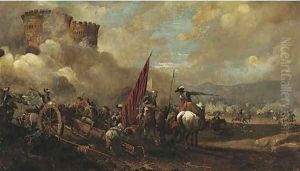Jacques Courtios, Il Borgognone Paintings
Jacques Courtios, also known as Jacopo Cortese or by his nickname Il Borgognone due to his Burgundian origin, was a Baroque painter who spent the majority of his career in Italy. Born in Saint-Hippolyte, Franche-Comté, which was then under Spanish rule, in 1621, Courtios was born into a time when the region was a melting pot of cultural influences, something that would inform his later work.
As a young man, Courtios traveled to Italy, the epicenter of the Baroque artistic movement, where he would be deeply influenced by the prevailing styles and the work of contemporaries such as Lanfranco and the Carracci family. He settled in Rome, which was a hub for artists from all over Europe. His work was characterized by dynamic compositions, a bold use of color, and a sense of movement that was typical of the Baroque style.
Courtios's work as an artist was versatile, encompassing battle scenes, landscapes, and religious subjects, but he is especially known for his battle paintings. His depictions of conflict were not only dramatic but also meticulously detailed, demonstrating an understanding of military attire and equipment. This niche established him as a unique figure within the Roman art scene, and his works were sought after by patrons who favored the grandeur and excitement of such scenes.
Despite his success, Il Borgognone's life was not without difficulties. His career was often overshadowed by his contemporaries, and he struggled with financial instability and recognition outside of his niche. However, his influence was felt by other artists, and his battle scenes would go on to inspire future generations. Jacques Courtios died in Rome in 1676, leaving behind a body of work that, while not as widely known as some of his peers, offers a captivating glimpse into the Baroque era's fascination with drama, movement, and the spectacle of war.
